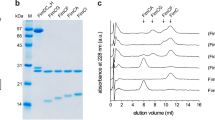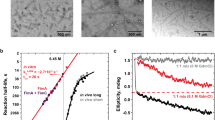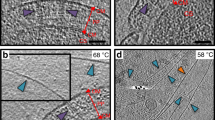Abstract
Type 1 pili from uropathogenic Escherichia coli are filamentous, noncovalent protein complexes mediating bacterial adhesion to the host tissue. All structural pilus subunits are homologous proteins sharing an invariant disulfide bridge. Here we show that disulfide bond formation in the unfolded subunits, catalyzed by the periplasmic oxidoreductase DsbA, is required for subunit recognition by the assembly chaperone FimC and for FimC-catalyzed subunit folding. FimC thus guarantees quantitative disulfide bond formation in each of the up to 3,000 subunits of the pilus. The X-ray structure of the complex between FimC and the main pilus subunit FimA and the kinetics of FimC-catalyzed FimA folding indicate that FimC accelerates folding of pilus subunits by lowering their topological complexity. The kinetic data, together with the measured in vivo concentrations of DsbA and FimC, predict an in vivo half-life of 2 s for oxidative folding of FimA in the periplasm.
This is a preview of subscription content, access via your institution
Access options
Subscribe to this journal
Receive 12 print issues and online access
$259.00 per year
only $21.58 per issue
Buy this article
- Purchase on Springer Link
- Instant access to full article PDF
Prices may be subject to local taxes which are calculated during checkout






Similar content being viewed by others
References
Choudhury, D. et al. X-ray structure of the FimC-FimH chaperone-adhesin complex from uropathogenic Escherichia coli. Science 285, 1061–1066 (1999).
Hahn, E. et al. Exploring the 3D molecular architecture of Escherichia coli type 1 pili. J. Mol. Biol. 323, 845–857 (2002).
Jones, C.H. et al. FimH adhesin of type 1 pili is assembled into a fibrillar tip structure in the Enterobacteriaceae. Proc. Natl. Acad. Sci. USA 92, 2081–2085 (1995).
Le Trong, I. et al. Donor strand exchange and conformational changes during E. coli fimbrial formation. J. Struct. Biol. 172, 380–388 (2010).
Le Trong, I. et al. Structural basis for mechanical force regulation of the adhesin FimH via finger trap-like β-sheet twisting. Cell 141, 645–655 (2010).
Sauer, F.G. et al. Structural basis of chaperone function and pilus biogenesis. Science 285, 1058–1061 (1999).
Sauer, F.G., Pinkner, J.S., Waksman, G. & Hultgren, S.J. Chaperone priming of pilus subunits facilitates a topological transition that drives fiber formation. Cell 111, 543–551 (2002).
Hung, D.L., Knight, S.D., Woods, R.M., Pinkner, J.S. & Hultgren, S.J. Molecular basis of two subfamilies of immunoglobulin-like chaperones. EMBO J. 15, 3792–3805 (1996).
Jones, C.H. et al. FimC is a periplasmic PapD-like chaperone that directs assembly of type 1 pili in bacteria. Proc. Natl. Acad. Sci. USA 90, 8397–8401 (1993).
Nishiyama, M., Ishikawa, T., Rechsteiner, H. & Glockshuber, R. Reconstitution of pilus assembly reveals a bacterial outer membrane catalyst. Science 320, 376–379 (2008).
Phan, G. et al. Crystal structure of the FimD usher bound to its cognate FimC-FimH substrate. Nature 474, 49–53 (2011).
Saulino, E.T., Thanassi, D.G., Pinkner, J.S. & Hultgren, S.J. Ramifications of kinetic partitioning on usher-mediated pilus biogenesis. EMBO J. 17, 2177–2185 (1998).
Vetsch, M. et al. Pilus chaperones represent a new type of protein-folding catalyst. Nature 431, 329–333 (2004).
Vetsch, M. et al. Mechanism of fibre assembly through the chaperone-usher pathway. EMBO Rep. 7, 734–738 (2006).
Remaut, H. et al. Donor-strand exchange in chaperone-assisted pilus assembly proceeds through a concerted beta strand displacement mechanism. Mol. Cell 22, 831–842 (2006).
Zavialov, A.V. et al. Structure and biogenesis of the capsular F1 antigen from Yersinia pestis: preserved folding energy drives fiber formation. Cell 113, 587–596 (2003).
Dodd, D.C. & Eisenstein, B.I. Kinetic analysis of the synthesis and assembly of type 1 fimbriae of Escherichia coli. J. Bacteriol. 160, 227–232 (1984).
Jacob-Dubuisson, F., Striker, R. & Hultgren, S.J. Chaperone-assisted self-assembly of pili independent of cellular energy. J. Biol. Chem. 269, 12447–12455 (1994).
Heras, B. et al. DSB proteins and bacterial pathogenicity. Nat. Rev. Microbiol. 7, 215–225 (2009).
Hiniker, A. & Bardwell, J.C. In vivo substrate specificity of periplasmic disulfide oxidoreductases. J. Biol. Chem. 279, 12967–12973 (2004).
Bardwell, J.C., McGovern, K. & Beckwith, J. Identification of a protein required for disulfide bond formation in vivo. Cell 67, 581–589 (1991).
Bringer, M.A., Rolhion, N., Glasser, A.L. & Darfeuille-Michaud, A. The oxidoreductase DsbA plays a key role in the ability of the Crohn′s disease-associated adherent-invasive Escherichia coli strain LF82 to resist macrophage killing. J. Bacteriol. 189, 4860–4871 (2007).
Jacob-Dubuisson, F. et al. PapD chaperone function in pilus biogenesis depends on oxidant and chaperone-like activities of DsbA. Proc. Natl. Acad. Sci. USA 91, 11552–11556 (1994).
Totsika, M., Heras, B., Wurpel, D.J. & Schembri, M.A. Characterization of two homologous disulfide bond systems involved in virulence factor biogenesis in uropathogenic Escherichia coli CFT073. J. Bacteriol. 191, 3901–3908 (2009).
Nishiyama, M. et al. Structural basis of chaperone-subunit complex recognition by the type 1 pilus assembly platform FimD. EMBO J. 24, 2075–2086 (2005).
Eidam, O., Dworkowski, F.S., Glockshuber, R., Grutter, M.G. & Capitani, G. Crystal structure of the ternary FimC-FimFt-FimDN complex indicates conserved pilus chaperone-subunit complex recognition by the usher FimD. FEBS Lett. 582, 651–655 (2008).
Pellecchia, M., Sebbel, P., Hermanns, U., Wuthrich, K. & Glockshuber, R. Pilus chaperone FimC-adhesin FimH interactions mapped by TROSY-NMR. Nat. Struct. Biol. 6, 336–339 (1999).
Puorger, C., Vetsch, M., Wider, G. & Glockshuber, R. Structure, folding and stability of FimA, the main structural subunit of type 1 pili from uropathogenic Escherichia coli strains. J. Mol. Biol. 412, 520–535 (2011).
Wunderlich, M. & Glockshuber, R. Redox properties of protein disulfide isomerase (DsbA) from Escherichia coli. Protein Sci. 2, 717–726 (1993).
Wunderlich, M., Otto, A., Seckler, R. & Glockshuber, R. Bacterial protein disulfide isomerase: efficient catalysis of oxidative protein folding at acidic pH. Biochemistry 32, 12251–12256 (1993).
Hennecke, J., Sillen, A., Huber-Wunderlich, M., Engelborghs, Y. & Glockshuber, R. Quenching of tryptophan fluorescence by the active-site disulfide bridge in the DsbA protein from Escherichia coli. Biochemistry 36, 6391–6400 (1997).
Schmid, F.X. Mechanism of folding of ribonuclease A. Slow refolding is a sequential reaction via structural intermediates. Biochemistry 22, 4690–4696 (1983).
Reimer, U. et al. Side-chain effects on peptidyl-prolyl cis/trans isomerisation. J. Mol. Biol. 279, 449–460 (1998).
Balbach, J. & Schmid, F.X. Prolyl isomerization and its catalysis in protein folding in Mechanisms of Protein Folding: Frontiers in Molecular Biology 2nd edn. (ed. Pain, R.H.) 212–249 (Oxford University Press, 2000).
Kobayashi, T. & Ito, K. Respiratory chain strongly oxidizes the CXXC motif of DsbB in the Escherichia coli disulfide bond formation pathway. EMBO J. 18, 1192–1198 (1999).
Barnhart, M.M. et al. PapD-like chaperones provide the missing information for folding of pilin proteins. Proc. Natl. Acad. Sci. USA 97, 7709–7714 (2000).
Krissinel, E. & Henrick, K. Inference of macromolecular assemblies from crystalline state. J. Mol. Biol. 372, 774–797 (2007).
Diederichs, K. Structural superposition of proteins with unknown alignment and detection of topological similarity using a six-dimensional search algorithm. Proteins 23, 187–195 (1995).
McDonald, I.K. & Thornton, J.M. Satisfying hydrogen bonding potential in proteins. J. Mol. Biol. 238, 777–793 (1994).
Kuehn, M.J. et al. Structural basis of pilus subunit recognition by the PapD chaperone. Science 262, 1234–1241 (1993).
Kelley, L.A. & Sutcliffe, M.J. OLDERADO: on-line database of ensemble representatives and domains. On line database of ensemble representatives and domains. Protein Sci. 6, 2628–2630 (1997).
Kabsch, W. A solution for the best rotation to relate two sets of vectors. Acta Crystallogr. A 32, 922–923 (1976).
Łasica, A.M. & Jagusztyn-Krynicka, E.K. The role of Dsb proteins of Gram-negative bacteria in the process of pathogenesis. FEMS Microbiol. Rev. 31, 626–636 (2007).
Yu, J. & Kroll, J.S. DsbA: a protein-folding catalyst contributing to bacterial virulence. Microbes Infect. 1, 1221–1228 (1999).
Hiniker, A., Collet, J.F. & Bardwell, J.C. Copper stress causes an in vivo requirement for the Escherichia coli disulfide isomerase DsbC. J. Biol. Chem. 280, 33785–33791 (2005).
Missiakas, D., Georgopoulos, C. & Raina, S. The Escherichia coli dsbC (xprA) gene encodes a periplasmic protein involved in disulfide bond formation. EMBO J. 13, 2013–2020 (1994).
Thomas, W.E., Trintchina, E., Forero, M., Vogel, V. & Sokurenko, E.V. Bacterial adhesion to target cells enhanced by shear force. Cell 109, 913–923 (2002).
Bann, J.G., Pinkner, J.S., Frieden, C. & Hultgren, S.J. Catalysis of protein folding by chaperones in pathogenic bacteria. Proc. Natl. Acad. Sci. USA 101, 17389–17393 (2004).
Capitani, G., Eidam, O., Glockshuber, R. & Grütter, M.G. Structural and functional insights into the assembly of type 1 pili from. Escherichia coli. Microbes Infect. 8, 2284–2290 (2006).
Collaborative Computational Project, Number 4. The CCP4 suite: programs for protein crystallography. Acta Crystallogr. D Biol. Crystallogr. 50, 760–763 (1994).
Acknowledgements
This work was supported by the Swiss National Science Foundation (grants 310030B-138657 and 31003A-122095 to R.G.) and the Swiss Federal Institute of Technology Zürich within the framework of the Swiss National Center for Competence in Research Structural Biology Program. The PhD position of M.A.S. was supported by a grant from the Research Committee of the Paul Scherrer Institute (FK-05.08.1) to G.C.
Author information
Authors and Affiliations
Contributions
The overall study was conceived and designed by M.D.C. and R.G. The biochemical experiments were performed by M.D.C. with contributions from C.P., M.A.S., O.E. and M.G.G., and G.C. contributed to the crystallographic structure determination, refinement and interpretation. M.D.C. and R.G. wrote the manuscript with the contribution of C.P., M.A.S. and G.C.
Corresponding author
Ethics declarations
Competing interests
The authors declare no competing financial interests.
Supplementary information
Supplementary Text and Figures
Supplementary Methods and Supplementary Results (PDF 2069 kb)
Rights and permissions
About this article
Cite this article
Crespo, M., Puorger, C., Schärer, M. et al. Quality control of disulfide bond formation in pilus subunits by the chaperone FimC. Nat Chem Biol 8, 707–713 (2012). https://doi.org/10.1038/nchembio.1019
Received:
Accepted:
Published:
Issue Date:
DOI: https://doi.org/10.1038/nchembio.1019



